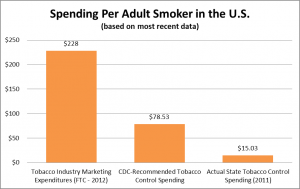 A state-by-state analysis of 2011 state funding from the Centers for Disease Control and Prevention shows there remains a yawning gap between state investments in tobacco prevention and control and CDC’s best practices recommendations.
A state-by-state analysis of 2011 state funding from the Centers for Disease Control and Prevention shows there remains a yawning gap between state investments in tobacco prevention and control and CDC’s best practices recommendations.
This is truly a missed opportunity as states that have made larger investments in tobacco prevention and control saw larger declines in cigarettes sales than the country as a whole. Research suggests smoking rates could have larger and more rapid reductions if tobacco control programs are adequately funded at the levels recommended in the best practices.
A recent Morbidity and Mortality Weekly Report from the CDC shows that state-level funding totals $658 million across all 50 states and compares that funding to the CDC-recommended level of $3.3 billion per year on a nationwide basis. In other words, actual spending was just below 20 percent of the CDC-reco mmended level.
mmended level.
A further look at the same data in comparison to the $9.6 billion per year the Federal Trade Commission estimates the tobacco industry spent on marketing support in 2012, shows how far state tobacco control funding lags. On a per smoker basis, the tobacco industry spent $228 per year for each U.S. adult smoker on marketing compared to CDC-recommended spending of approximately $78.53 per smoker per year for tobacco control, and actual state spending on tobacco control of only $15.03 per smoker per year.
The CDC numbers help make the case that investment in tobacco control is a life and death matter. Big tobacco wildly outspends even the most well-funded state tobacco control programs and yet spending on evidence-based programs has helped drive down cigarette sales and smoking rates.
We need to invest more because lives are at stake – particularly young lives. Youth cigarette use is down to 8 percent but overall tobacco use among youth remains flat. Young people are increasingly using unregulated tobacco products such as little cigars, hookah and new e-cigarette options. We need to invest more, not less, in the prevention programs that have been proven effective if we hope to stop the tobacco epidemic from claiming the lives of yet another generation.
All 50 states and the District of Columbia have state tobacco control programs. However, according to the CDC, only Alaska and North Dakota are funding tobacco control programs at CDC-recommended levels. According to the CDC, thirteen states funded tobacco control programs at less than 10 percent of the CDC-recommended levels (Connecticut, Georgia, Kansas, Kentucky, Maryland, Massachusetts, Michigan, New Hampshire, New Jersey, Ohio, South Carolina, Tennessee, and Texas).
Legacy offers more information about state-level tobacco use and control online.
Robin Koval
CEO & President
Legacy®